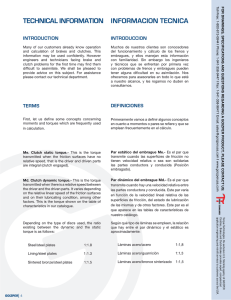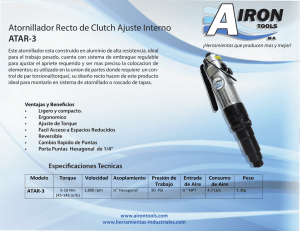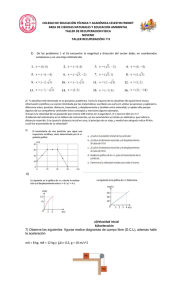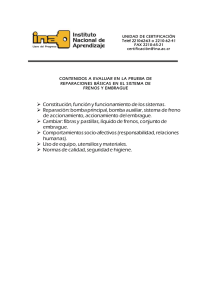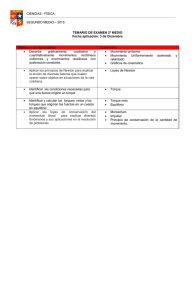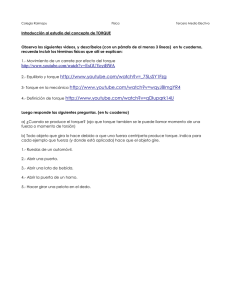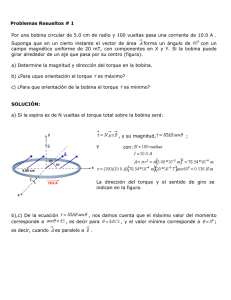Technical Information
Anuncio
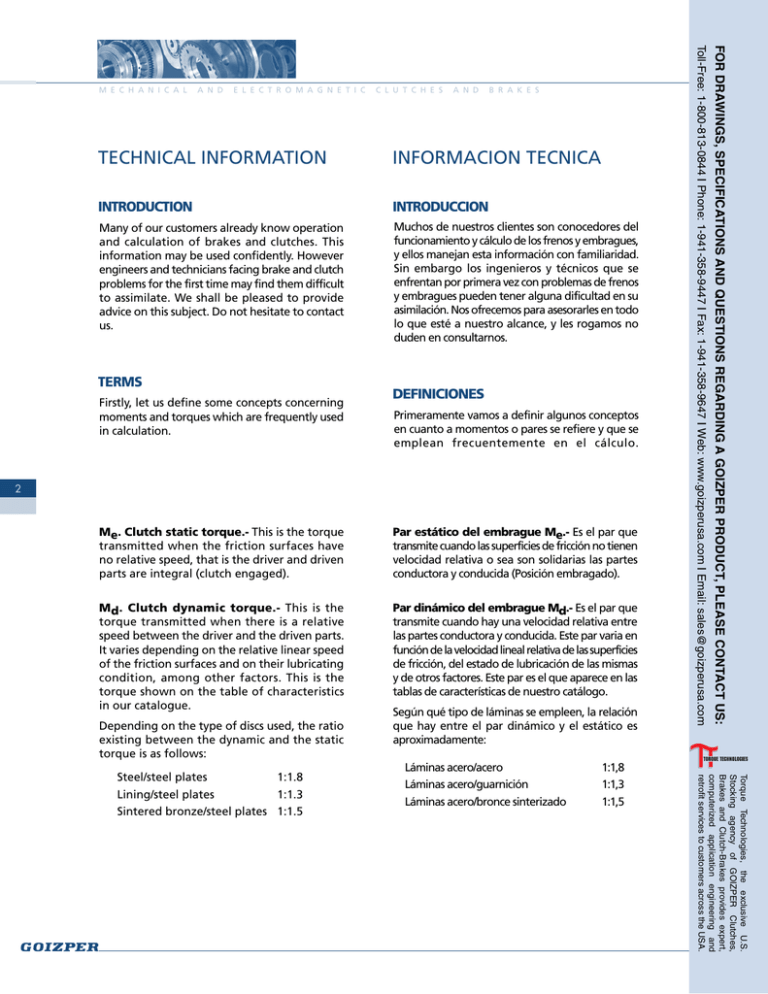
E L E C T R O M A G N E T I C C L U T C H E S A N D B R A K E S TECHNICAL INFORMATION INFORMACION TECNICA INTRODUCTION INTRODUCCION Many of our customers already know operation and calculation of brakes and clutches. This information may be used confidently. However engineers and technicians facing brake and clutch problems for the first time may find them difficult to assimilate. We shall be pleased to provide advice on this subject. Do not hesitate to contact us. Muchos de nuestros clientes son conocedores del funcionamiento y cálculo de los frenos y embragues, y ellos manejan esta información con familiaridad. Sin embargo los ingenieros y técnicos que se enfrentan por primera vez con problemas de frenos y embragues pueden tener alguna dificultad en su asimilación. Nos ofrecemos para asesorarles en todo lo que esté a nuestro alcance, y les rogamos no duden en consultarnos. TERMS Firstly, let us define some concepts concerning moments and torques which are frequently used in calculation. DEFINICIONES Primeramente vamos a definir algunos conceptos en cuanto a momentos o pares se refiere y que se emplean frecuentemente en el cálculo. 2 Me. Clutch static torque.- This is the torque transmitted when the friction surfaces have no relative speed, that is the driver and driven parts are integral (clutch engaged). Par estático del embrague Me.- Es el par que transmite cuando las superficies de fricción no tienen velocidad relativa o sea son solidarias las partes conductora y conducida (Posición embragado). Md. Clutch dynamic torque.- This is the torque transmitted when there is a relative speed between the driver and the driven parts. It varies depending on the relative linear speed of the friction surfaces and on their lubricating condition, among other factors. This is the torque shown on the table of characteristics in our catalogue. Par dinámico del embrague Md.- Es el par que transmite cuando hay una velocidad relativa entre las partes conductora y conducida. Este par varia en función de la velocidad lineal relativa de las superficies de fricción, del estado de lubricación de las mismas y de otros factores. Este par es el que aparece en las tablas de características de nuestro catálogo. Depending on the type of discs used, the ratio existing between the dynamic and the static torque is as follows: Láminas acero/acero Láminas acero/guarnición Láminas acero/bronce sinterizado 1:1,8 1:1,3 1:1,5 Torque Technologies, the exclusive U.S. Stocking agency of GOIZPER Clutches, Brakes and Clutch-Brakes provides expert, computerized application engineering and retrofit services to customers across the USA. Steel/steel plates 1:1.8 Lining/steel plates 1:1.3 Sintered bronze/steel plates 1:1.5 Según qué tipo de láminas se empleen, la relación que hay entre el par dinámico y el estático es aproximadamente: For drawings, specifications and questions regarding a GOIZPER product, please contact us: A N D Toll-Free: 1-800-813-0844 | Phone: 1-941-358-9447 | Fax: 1-941-358-9647 | Web: www.goizperusa.com | Email: sales@goizperusa.com M E C H A N I C A L E L E C T R O M A G N E T I C If the masses to be accelerated have a linear motion, their moments are referred to the clutch shaft, applying the following formula: J red. = 91 • m • A N D B R A K E S Si las masas a acelerar tienen un movimiento lineal, sus momentos se reducen al eje del embrague, por la siguiente fórmula: v2 n2 J red. = 91 • m • m V = Masses in linear motion, in kg. = Speed of the above mentioned masses in m/sec. n = R.p.m. of the clutch. J red = Moment of inertia in kgm2 referred to the clutch shaft. m V Mt. Total torque.- This is the sum of the load torque and the acceleration torque. Mt = Par resistente total M t = Mc + Ma 4 C L U T C H E S v2 n2 = Masas en movimiento lineal (kg). = Velocidad de las citadas masas en m/seg. n = revoluciones por minuto del embrague. J red = momento de inercia en kgm2 reducido al eje del embrague. Su valor resulta de la suma de los pares de carga y aceleración. Mt = Mc + Ma The J of a 100 mm thick solid iron cylinder, it works out by means of the following formula: El J de un cilindro macizo de hierro, de 100 mm de espesor, se obtiene por la fórmula: J = 77 • D4 J = 77 • D4 Where D is its external diameter in m, and J is the moment of inertia in Kgm2. Siendo D su diámetro exterior en m J es el momento de inercia en kgm2. ACCELERATION TIME TIEMPO DE ACELERACION The acceleration time can be calculated using the following formula: Para hallar el tiempo de aceleración, utilice la siguiente fórmula: ta = 9,55 (Mt ± Mc) ta = in seconds = where acceleration or deceleration is concerned. n2 + n1 = where inversion is concerned. Mt - Mc = in Nm where acceleration is concerned. Mt + Mc = in Nm where deceleration is concerned. n2 - n 1 J (n2 ± n1 ) 9,55 (Mt ± Mc) in seconds = en casos de aceleración o deceleración. n2 + n1 = en casos de inversión. Mt - Mc = en Nm, en casos de aceleración. Mt + Mc = en Nm, en casos de deceleración. Torque Technologies, the exclusive U.S. Stocking agency of GOIZPER Clutches, Brakes and Clutch-Brakes provides expert, computerized application engineering and retrofit services to customers across the USA. n2 - n 1 J (n2 ± n1 ) For drawings, specifications and questions regarding a GOIZPER product, please contact us: A N D Toll-Free: 1-800-813-0844 | Phone: 1-941-358-9447 | Fax: 1-941-358-9647 | Web: www.goizperusa.com | Email: sales@goizperusa.com M E C H A N I C A L F R E N O S M E C Á N I C O S Y E L E C T R O M A G N É T I C O S CALORIFIC CAPACITY CAPACIDAD CALORIFICA In order to calculate the produced heat Q during every operation, use the following formula: Para calcular el calor Q producido en cada maniobra, aplique la siguiente fórmula: Q= J (n2 ± n1 )2 764 • 103 • Mt (Mt ± Mc) in kcal. The work produced by the clutch or brake during every operation will be transformed into heat, it will be absorbed by the friction surfaces of the plates or dissipated into the air, without exceeding the calorific capacity of the clutch. In order to work out the maximum frequency per hour of clutch operations the following should be taken into account: friction surface area of the discs in cm2, number of friction surfaces and calorific value (dissipation capacity in Kcal/cm2 hour). For this last element and according to the type of plate, the following values should be considered: 1) steel/steel plates Splash lubrication ≈ 0.4 ÷ 0.5 Inside lubrication ≈ 0.6 ÷ 0.7 Maximum temperature of the friction surfaces: 200° C. 2) sintered bronze/steel plates Dry running = 0,4 ÷ 0,5 Splash lubrication 1 ÷ 1.2 Inside lubrication 1,5 ÷ 2 Maximum temperature: 500° C. 3) lining/steel plates Single-plate units, 1 ÷ 2 dry running. Multi-plate units, 0,2 ÷ 0,3 dry running. J (n2 ± n1 )2 764 • 103 • Mt (Mt ± Mc) in kcal. El trabajo producido por el embrague o freno en cada maniobra que se transforma en calor y es absorbido o transmitido al aire por las superficies de fricción de los discos, sin sobrepasar la capacidad calorifica del embrague. Para calcular la frecuencia máxima de maniobras por hora admisibles para el embrague, hay que tener en cuenta: superficies de rozamiento de los discos en cm2, número de las mismas y el valor calorífico (Poder de disipación en Kcal/cm2 hora). Para este último factor y según el tipo de disco se pueden considerar los siguientes valores: 1) discos acero/acero Lubricación por barboteo ≈ 0,4 ÷ 0,5 Lubricación interior ≈ 0,6 ÷ 0,7 La temperatura de las superficies de rozamiento no debe sobrepasar 200° C. 2) discos acero/sinterizado En seco = 0,4 ÷ 0,5 Lubricación por barboteo 1 ÷ 1,2 Lubricación interior 1,5 ÷ 2 La temperatura no debe ser superior a 500° C. 3) discos acero/guarnición Monodiscos 1 ÷ 2 en seco Multidiscos 0,2 ÷ 0,3 en seco. La temperatura máxima será 300° C. 5 Torque Technologies, the exclusive U.S. Stocking agency of GOIZPER Clutches, Brakes and Clutch-Brakes provides expert, computerized application engineering and retrofit services to customers across the USA. Maximum temperature: 300° C. Q= For drawings, specifications and questions regarding a GOIZPER product, please contact us: Y Toll-Free: 1-800-813-0844 | Phone: 1-941-358-9447 | Fax: 1-941-358-9647 | Web: www.goizperusa.com | Email: sales@goizperusa.com E M B R A G U E S E L E C T R O M A G N E T I C C L U T C H E S A N D B R A K E S Furthermore, the energy produced per operation and per cm2 of surface area should not exceed: Además, la energía producida por operación y por cm2 de superficie no deberá pasar de: * 25-50 cal/cm2 for wet operation of sintered bronze/steel plates. * 25-50 cal/cm2 para discos de acero-bronce sinterizado en aceite. * 6-12 cal/cm2 for wet operation of steel/steel plates. * 6-12 cal/cm2 para acero-acero en aceite. * 25-35 cal/cm2 acero-bronce sinterizado en seco. * 25-35 cal/cm 2 for dry operation sintered bronze/steel plates. * 50-100 cal/cm 2 para acero o fundiciónguarnición orgánica en seco. * 50-100 cal/cm2 for dry operation of lining/steel or cast iron plates. DETERMINACIÓN DEL TAMAÑO DEL EMBRAGUE DETERMINING CLUTCH SIZE In order to determine clutch size, consider the máximum resisting torque to be overcome. 6 While in operation in most cases impact unknown peaks may happen. For that reason a service factor K determined by experience should be taken into consideration. It will depend on the characteristics of driving and driven machines. Para determinar el tamaño del embrague, se tendrá en cuenta el par resistente máximo que tiene que vencer. Durante el funcionamiento se pueden producir puntas de choque desconocidas en la mayoría de los casos; por esta razón hay que tener en cuenta un factor de seguridad K determinado por la experiencia, y que depende de la naturaleza de las máquinas motriz y receptora. Md ≥ Mt • K Md ≥ Mt • K If the machine is not equipped with a flywheel, calculate clutch torque using motor power, with the following formula: Md= 955 • Pm = n = K = Md = Pm n K Motor power in kw. Clutch speed in r.p.m. Safety factor. Dynamic clutch torque in daNm. Md= 955 • Pm = n = K = Md = Pm n K Potencia del motor en kw. Velocidad del embrague en r.p.m. Factor de seguridad. Par dinámico del embrague en daNm. En ciertas aplicaciones, en las que la velocidad y frecuencia de maniobras es elevada, el cálculo debe ser completado con un estudio de disipación del calor cuyo cálculo basado en fórmulas empíricas, rogamos nos confíen. Torque Technologies, the exclusive U.S. Stocking agency of GOIZPER Clutches, Brakes and Clutch-Brakes provides expert, computerized application engineering and retrofit services to customers across the USA. For some applications with a high speed and operation frequency, the calculation should be complementad by a study on heat dissipation based on empirical formulations. Please let us do this for you. En el caso de que la máquina no lleve incorporado un volante de inercia se puede calcular el par del embrague partiendo de la potencia del motor, en cuyo caso se aplicará la siguiente fórmula: For drawings, specifications and questions regarding a GOIZPER product, please contact us: A N D Toll-Free: 1-800-813-0844 | Phone: 1-941-358-9447 | Fax: 1-941-358-9647 | Web: www.goizperusa.com | Email: sales@goizperusa.com M E C H A N I C A L F R E N O S M E C Á N I C O S Y E L E C T R O M A G N É T I C O S K SAFETY FACTOR VALUES Type of driving machine Type of driven machine Internal Internal Infernal Electric combustion combustion combustion motor engine 4 or engine 2 or engine 6 cylinders 3 cylinders 1-cylinder Lower J Centrifugal pumps, small fans, centrifugal compressors 1,5 1,8 2 2,5 Low J Elevators, Large fans, Belt conveyors, Wood and metal machine tools, Small textile Machines 1,7 2 2,2 2,8 Medium J Rotary furnaces, Elevators, Mixers, Shearing machines, Stamping machines, Pump and piston compressors, Sharpening machines, Heavy textile machines, Mills. 2 2,3 2,5 3,2 High J and high load peaks Shovels, Polishing machines, Tractors, Light metal rollers, Crushing machines, Large fans, Molding presses, Locomotives, Large piston pumps, Cranes. 2,5 2,7 3 3,5 Higher J and high load peaks Forging presses, Large piston compressors, Steel and rubber rollers, Saws, Carrier rollers, Filing machines, Wire drawing machines, Plate bending machines, Large crushing machines, Paper calenders, Spinning machines. 3 3,2 3,5 4 7 VALORES DEL FACTOR DE SEGURIDAD K Tipo de máquina motriz Tipo de máquina receptora Motor Motor Motor Motor explosión explosion eléctrico explosión 4 ó 6 cilind. 2 ó 3 cilind. Monocilindr. 1,5 1,8 2 2,5 J pequeño Elevadores, Grandes ventiladores, Transportadores a cinta, Máquinas herramientas para madera y metal, Pequeña máquina textil. 1,7 2 2,2 2,8 J mediano Horno rotativo, montacargas, Mezcladoras, Cizalla, Máquina de estampar, Bomba y compresor de pistón, Afiladora, Máquina textil pesada, Molinos 2 2,3 2,5 3,2 J elevado y fuertes puntas de carga Palas, Pulidoras, Tractores, Laminadoras de metales ligeros, Trituradoras, Grandes ventiladores, Prensas de matrizar, Locomotoras, Bombas grandes de pistón, Grúas. 2,5 2,7 3 3,5 J muy elevado y fuertes puntas de carga Prensas de forjar, Compresor de pistón grande, Laminadoras para acero y caucho, Sierras alternativas, Rodillos transportadores, Limadoras, Bancos de estiraje, Plegadoras, Grandes trituradores, Calandras para papel, Centrifugadoras. 3 3,2 3,5 4 Torque Technologies, the exclusive U.S. Stocking agency of GOIZPER Clutches, Brakes and Clutch-Brakes provides expert, computerized application engineering and retrofit services to customers across the USA. J muy reducido Bombas centrífugas, pequeños ventiladores, compresor centrífugo. For drawings, specifications and questions regarding a GOIZPER product, please contact us: Y Toll-Free: 1-800-813-0844 | Phone: 1-941-358-9447 | Fax: 1-941-358-9647 | Web: www.goizperusa.com | Email: sales@goizperusa.com E M B R A G U E S
